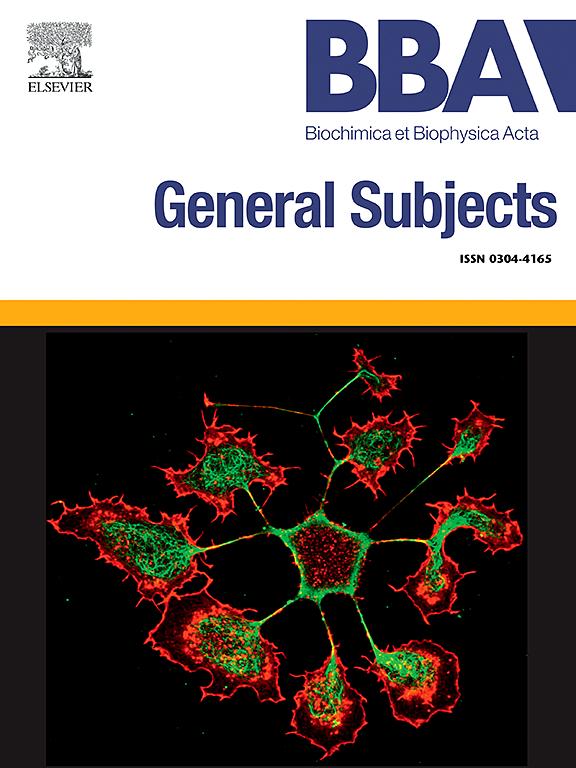Inhibition of amyloid formation of prion fragment (106–128) by polyphenolic compounds
IF 2.2
3区 生物学
Q3 BIOCHEMISTRY & MOLECULAR BIOLOGY
Biochimica et biophysica acta. General subjects
Pub Date : 2025-02-21
DOI:10.1016/j.bbagen.2025.130778
引用次数: 0
Abstract
Prion diseases are characterized by the self-association and amyloid formation of misfolded prion proteins. Developing effective inhibitors of protein aggregation is critical for therapeutic intervention. In this study, we systematically evaluated a range of polyphenolic compounds as potential inhibitors of amyloid fibril formation of PrP(106–128), a prion fragment crucially involved in prion aggregation and propagation. Our findings demonstrate that the basic aromatic backbone structure of flavone alone is insufficient to inhibit PrP(106–128) amyloid formation. Remarkably, flavone molecules containing adjacent hydroxyl groups on the phenolic B or A ring efficiently inhibited PrP(106–128) fibrillization, whereas compounds lacking vicinal hydroxyl groups were less effective in inhibiting amyloid formation. Epigallocatechin-3-gallate (EGCG) was one of the most potent inhibitors found in this study, with the gallate moiety playing an active role in the inhibitory function. Our findings indicate a structure-dependent inhibition activity of the phenolic small molecules, where the number and positioning of hydroxyl groups on the phenyl ring play a pivotal role in inhibiting the aggregation of the peptide. The auto-oxidation of the catechol or pyrogallol moieties to form quinone structures, followed by their reaction with amino acid side chains of the peptide to form covalent adducts, likely account for the inhibitory activity of these phenolic compounds on PrP(106–128) amyloidogenesis. These results will help the design of novel polyphenolic molecules with optimized structural features as potent inhibitors of amyloid formation of both PrP(106–128) and the full-length prion proteins.

多酚类化合物对朊病毒片段(106-128)淀粉样蛋白形成的抑制作用。
朊病毒疾病的特点是错误折叠的朊病毒蛋白的自结合和淀粉样蛋白的形成。开发有效的蛋白质聚集抑制剂对治疗干预至关重要。在这项研究中,我们系统地评估了一系列多酚类化合物作为PrP淀粉样纤维形成的潜在抑制剂(106-128),PrP是朊病毒聚集和繁殖的关键片段。我们的研究结果表明,仅黄酮的基本芳香骨架结构不足以抑制PrP(106-128)淀粉样蛋白的形成。值得注意的是,在酚B或酚A环上含有相邻羟基的黄酮分子有效地抑制了PrP(106-128)的成纤维,而缺乏相邻羟基的黄酮分子在抑制淀粉样蛋白形成方面效果较差。表没食子儿茶素-3-没食子酸酯(EGCG)是本研究中发现的最有效的抑制剂之一,其没食子酸酯部分在抑制功能中发挥积极作用。我们的研究结果表明酚类小分子的抑制活性具有结构依赖性,其中苯基环上羟基的数量和位置在抑制肽的聚集中起关键作用。儿茶酚或邻苯三酚部分的自动氧化形成醌结构,随后它们与肽的氨基酸侧链反应形成共价加合物,可能解释了这些酚类化合物对PrP(106-128)淀粉样蛋白形成的抑制活性。这些结果将有助于设计具有优化结构特征的新型多酚分子,作为PrP(106-128)和全长朊病毒蛋白淀粉样蛋白形成的有效抑制剂。
本文章由计算机程序翻译,如有差异,请以英文原文为准。
求助全文
约1分钟内获得全文
求助全文
来源期刊

Biochimica et biophysica acta. General subjects
生物-生化与分子生物学
CiteScore
6.40
自引率
0.00%
发文量
139
审稿时长
30 days
期刊介绍:
BBA General Subjects accepts for submission either original, hypothesis-driven studies or reviews covering subjects in biochemistry and biophysics that are considered to have general interest for a wide audience. Manuscripts with interdisciplinary approaches are especially encouraged.
 求助内容:
求助内容: 应助结果提醒方式:
应助结果提醒方式:


